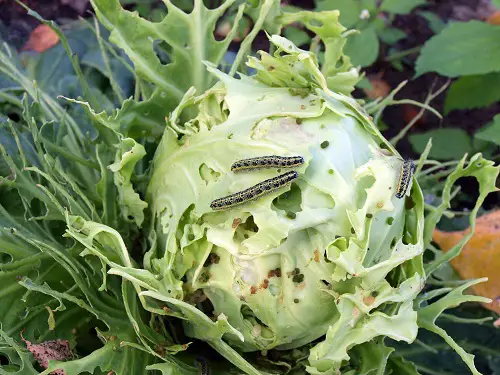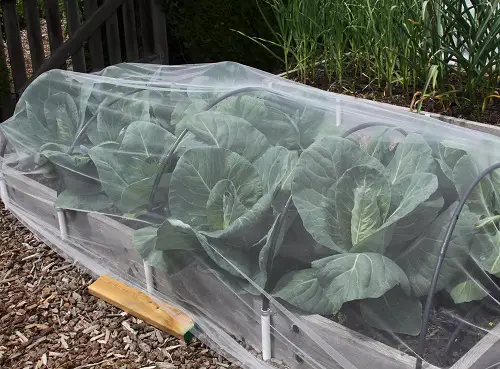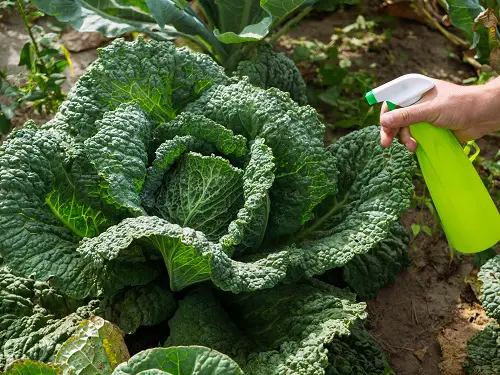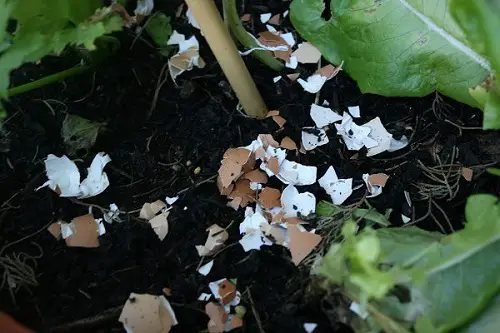Save yourself from this brassica nightmare! We share Ways to Get Rid of Cabbage Moths and Worms and protect your produce.

One day, your brassicas are swaying happily in the breeze, and the next, out of nowhere, you’ve been invaded by the worst—cabbage moths and worms! They sneak up on you, camouflaged and relentless. But before your harvest becomes a lost cause, here are ways to get rid of them!
What Are Cabbage Moths and Worms?
Cabbage worms are the larvae of the Cabbage White Butterfly (Pieris rapae). They are small, green caterpillars with faint yellow stripes along their sides. Cabbage moths (Mamestra brassicae), on the other hand, are nocturnal moths.
Both are pretty common and just as dreadful! They don’t harm the plants themselves but lay eggs on the underside of the leaves of various cole crops—cruciferous cool-season veggies that are descendants of wild cabbage. These include cabbage, broccoli, cauliflower, collards, kale, etc.
The larvae then chew holes into them and also leave behind frass—powdery refuse—which contaminates the plant yield.
Ways to Get Rid of Cabbage Moths and Worms
Before getting into it, here’s a reminder to always opt for gentle preventive measures when you can. A proactive approach towards deterring these pests can reduce the need for more aggressive treatments later on.
1. Inspect Regularly & Remove Manually

The critters in question are excellent at camouflaging, so be extra vigilant in looking out for telltale signs of cabbage worms and moths on your vegetation. Look for holes or ragged edges on leaves, clusters of eggs on the undersides of leaves, and silk webbing around the plants. If the leaves start wilting with no obvious cause for stress, this could also be a sign.
By regularly checking on your plants, especially the undersides, you’ll catch their eggs and larvae before they get out of hand. When you find them, just remove the infected parts and pests with your hands and drop them in a container of soapy water to get rid of them for good!
2. Floating Row Covers

Have you ever considered clothing your plants? A floating row cover can be your garden’s first line of defense, physically blocking pests from laying eggs on your crops. This physical barrier is lightweight and allows sunlight and rain to filter through. It also ensures good air circulation, all while repelling pests.
These row covers are held up on hoop structures and are useful in keeping away squirrels, deer, rabbits, and other unwanted visitors. They help secure a productive yield without any harmful after-effects.
3. Neem Oil
You may recognize neem oil as an herbal cure-all, but it’s also a plant’s best friend! Mix a tablespoon with a gallon of water and spray it thoroughly on the plants, especially the undersides of leaves, where the larvae and eggs inhabit.
This treatment is a chemical-free method of disrupting the life cycle of cabbage worms and moths. Reapply every week to consistently manage common garden pests without harming beneficial insects.
4. Introduce Beneficial Predators

Ladybugs, lacewing larvae, predatory beetles, and parasitic wasps are all beneficial insects that help control the population of cabbage worms and moths. Wasps like Trichogramma lay their eggs inside the moth eggs, and their larvae will slowly devour the moth caterpillar within.
Another wasp, Cotesia Glomerata, targets and parasitizes cabbage worms, killing them. Some of these are also pollinators that are attracted to flowers like marigolds or alyssums. These flowers provide nectar and habitat, all building up a healthy ecosystem together.
Check out this article on beneficial insects you should avoid killing in the garden.
5. Bacillus thuringiensis (Bt)

Bacillus thuringiensis (Bt) is a bacteria that dwells in soil and is a common ingredient in organic pesticides. Buy a premixed spray or a concentrate, as both are effective in killing caterpillars and toxic for the larvae of butterflies and moths and, consequently, our cabbage pests.
With a concentrate, dilute it with water as per instructions and apply it to the infected plants. When these larvae and caterpillars ingest it, it kills them by disrupting their digestive system. Learn how to apply it here!
6. Companion Planting

Growing herbs like thyme, sage, or dill near these pests-prone crops is another way to get rid of cabbage moths and worms. The heady aromas of these herbs repel cabbage moths by confusing them from even coming near the plants, let alone laying eggs!
Herbs are like the tastiest fortress you can build for your crops. In addition to repelling pests, they also help improve flavors of produce and bring a host of benefits. Curious? Check out these herbs to plant with your veggies!
7. Diatomaceous Earth

Made of the fossilized remains of tiny aquatic organisms called diatoms, which are replete in silica, diatomaceous earth dehydrates and kills bugs by absorbing oils and fats from their cuticles. Spread it across the base of plants for a natural barrier against pests like cabbage worms.
With regular application—especially after rains— this fine powder consistently protects vegetation. However, it is harmful to breathe in directly and should be kept away from children and pets.
8. Garlic Spray
From the kitchen to your garden, garlic contains many sulfur components that lend its strong, pungent flavor. It is great at getting rid of cabbage worms and moths. Peel some cloves of garlic, crush them, and boil them in water. Mix 4 cups of garlic water and about 1 to 2 tablespoons of mild bleach-free soap together to make a solution.
Allow it to sit overnight, and then fill a spray bottle and use it on infected crops. Regular application provides an organic, non-toxic method for protecting your garden from unwanted visitors. Check out our blog on how to prepare it effectively!
9. Apply Eggshells

Crushed eggshells are another kitchen solution that is easily accessible and harm-free to deter these pests. The sharp edges prevent worms from crawling up and munching on the leaves.
This also enhances the health of your plants, as eggshells add calcium to the soil when they decompose. Read our blog to learn more about how to use them!
10. Crop Rotation

Crop rotation might sound like an extra chore, but it’s worth it. Changing the location for your cabbages and other crops every season breaks the life cycle of pests that tend to overwinter in the soil.
This is a simple yet effective strategy for preventing cabbage worms and moths from gaining a foothold and causing significant damage in your garden. Crop rotation will eventually mean healthier plants and, thus, better harvests.
11. Introduce Beauveria bassiana

Beauveria bassiana is a soil-friendly fungus that acts as a potent bio-insecticide. When applied to plants, it seeks out and kills several pests, such as cabbage worms and moths.
This fungus does so by entering the insect’s cuticle, multiplying inside, and killing it. It controls the population of pests, hence reducing the need for chemical pesticides. Learn how to use it here.
12. Clean up Debris
Garden debris from the previous harvest can be a breeding ground for insect larvae and eggs, amplifying pest issues in the upcoming seasons. Tilling, mowing, and removing all plant debris promptly reduces the risk of invasion from cabbage moths and worms and also improves your garden’s hygiene and health.
Use these methods to detect, prevent, or treat the scourge of cabbage moths and worms in your garden. When you finally reap the rewards of a clean and delightful cabbage family yield, you’ll know it was all worth the effort—and you’ll have yourself to thank!


